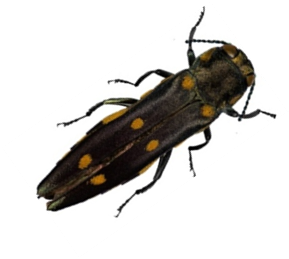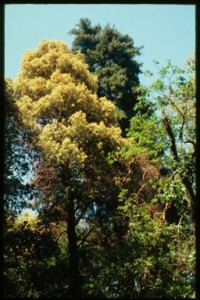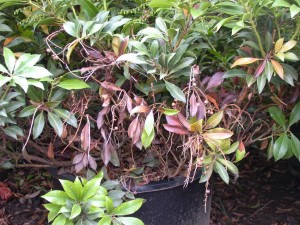Oak trees are immensely symbolic to many people and many are magnificent. Congress even designated the red oak as America’s “national tree”.
Photo of Q. rubra leaves by Becca MacDonald, Sault College; www.bugwood.org
Of course, there are many kinds – from those that span many states to those that grow in just some special areas. USDA’s Plants database lists more than 300 native species for the U.S. alone. Many provide substantial ecosystem services and all parts of the country would be poorer without them.
Despite our oaks’ importance, we are doing far too little to protect them from the full range of non-native insects and diseases that pose threats.
CURRENT THREATS IN THE EAST
In the East (from the Atlantic to the Great Plains), oaks are under attack from at least four non-native pests:
- One of these, the European gypsy moth (Lymantria dispar), is the target of major containment and suppression programs operated by USDA Animal and Plant Health Inspection Service (APHIS), the US Forest Service and the states. In fact, the US Forest Service spends half of its entire budget for studying and managing non-native pests on the European gypsy moth. In part, this is because the European gypsy moth is so widespread, with outbreaks from Nova Scotia to Wisconsin and south across eastern Ohio to Virginia. (See the map of EGM range here). It also attacks a wide range of tree and shrub species.
But other oak-killing insects and diseases, some with the potential to be at least as damaging, receive far fewer resources.
- Oak wilt (caused by the fungus Ceratocystis fagacearum) is widespread from central Pennsylvania across Iowa, down the Appalachians in West Virginia and North Carolina-Tennessee border, in northern Arkansas and with large areas affected in central Texas. There is an isolated outbreak in New York State. (See map here). According to the US Forest Service, oak wilt is one of the most serious tree diseases in the eastern U.S. It attacks primarily red oaks and live oaks. It is spread by both bark-boring beetles and root grafts.
- From Long Island along the coast into Nova Scotia and into central Massachusetts, oaks are being killed by the winter moth (Operophtera brumata). Like the gypsy moth, the winter moth has a wide host range. (For more information, see here). A small program led by Joseph Elkington of the University of Massachusetts has focused on biocontrol. Biocontrol agents have successfully reduced winter moth damage in Nova Scotia and the Pacific Northwest. First results are promising in New England.
CURRENT THREATS IN THE WEST
In the West, millions of oaks have been killed by several pathogens and insects that are established and spreading; and additional threats loom.
- Coast live oaks, canyon live oaks, California black oaks, Shreve’s oaks, and tanoaks growing in coastal forests from Monterey County north to southern Oregon that catch fog/rain are being killed by sudden oak death and here. Sudden oak death has killed over one million tanoaks as well as hundreds of thousands of coast live oaks and other trees. In early days of the infestation, Oregon – with considerable help from the US Forest Service – tried to eradicate a small infestation in Curry County. The inherent difficulty in managing a pathogen and interruptions in funding caused that effort to fail. The state is now focused on trying to slow spread of the disease.
- In California, coast live oaks, black oaks, and canyon oaks in the southern part of the state – primarily in San Diego County, but also parts of San Bernardino, Orange, and Los Angeles counties – are being killed by goldspotted oak borer and here. At least 100,000 black oaks have been killed in less than 20 years. Neither the State of California nor USDA APHIS has adopted regulations aimed at preventing spread of the goldspotted oak borer, despite oaks being at risk throughout California.
- Two more wood-boring beetles threaten oaks in southern California. In five counties in the region, coast live oaks, canyon live oaks, Engelman oaks, and valley oaks – and many other kinds of trees – are being killed by a disease transmitted by the polyphagous and Kuroshio shot hole borers and here. The polyphagous and Kuroshio shot hole borers attack more than 300 plant species, including tree species that anchor the region’s riparian areas as well as half of the trees planted in urban areas of the region.
- Also, oaks on the West coast would be attacked by gypsy moths should they reach the area. The risk is two-fold – the Asian gypsy moth continually is carried to the area on ships bearing imports from Asia (as discussed in my blog in March). And the European gypsy moth is sometimes taken across the country on travellers’ vehicles, outdoor furniture, or firewood. Both the West Coast states and USDA search vigilantly for any signs of gypsy moth arrival.
Or course, other non-native pests can also be introduced or spread to new, vulnerable, areas. I have blogged about the risk to the East from sudden-oak-death infested plants moving in the nursery trade (see blogs from July 2015). The polyphagous and Kuroshio shot hole borers might also threaten forests in other warm regions of the country such as the Gulf Coast, where some known and potential host trees grow.
ADDITIONAL THREATS
Two apparent threats have come to our attention recently: fungi in the genus Diplodia and another disease called foamy bark canker. There is some uncertainty whether the insects or pathogens are non-native. Both are apparently closely linked to drought stress.
- two Diplodia fungi – Diplodia corticola and quercivora – have been detected in both Florida and California. These fungi were previously known to kill oaks in the Mediterranean region.
According to Mullerin and Smith (2015), one or both of these fungi might be native to North America. Diplodia corticola was first identified in the 1980’s in cork oaks (Quercus suber L.) in Mediterranean countries. It has since been determined to be the cause of mortality in other species of European oaks. D. corticola was first reported in California in 1998 in coast live oak trees (Q. agrifolia) that had been colonized by bark and ambrosia beetles. There, it has been an important factor in the deaths of thousands of acres of coast and canyon live oaks (Q. chrysolepis) since 2002 (Mullerin and Smith 2015). In California, periodic diebacks since the late 1970s have been associated with droughts. Symptoms have mainly shown up in coast live oak (Q. agrifolia), black oak (Q. kelloggii), and valley oak (Q. lobata). Dieback is noticeable in at least 20 California counties, throughout most of the range of coast live oak. (See here.)
The first detection of D. corticola in southern Florida was in 2010; D. quercivora was detected in 2013. In Florida, these fungi attack live oaks (Quercus virginiana). Almost all the symptomatic trees in Florida grow in cultivated settings where they are exposed to various stresses. In addition, most of the state experienced severe drought in 2010, the year reports of dieback began (Mullerin and Smith 2015).
Host range studies indicate that 33 species of oaks and one species of chestnut that grow in the Southeast are vulnerable, to varying degrees, to D. corticola. Oaks in the red oak group (Section Lobatae) are more vulnerable than are white oaks (Section Quercus) (Mullerin and Smith 2015). In the test, the most vulnerable appear to be the following species native to the Southeast: Q. laurifolia, Q. virginiana, Q. geminata, Q. chapmanni, Q. laevis (turkey oak), Q. phellos, Q. pumila, and Q. incana. (source: poster presented by Dreaden, Black, Mullerin, Smith at the 2016 USDA Invasive Species Research Forum.)
It is unknown how Diplodia corticola & Diplodia quercivora colonize oaks. However, members of the family (Botryosphaeriaceae) generally enter plants through wounds, including leaf scars, or stomata open for gas exchange. They often live harmlessly as endophytes within the plant, becoming pathogenic when the plant is stressed by environmental factors such as drought, flooding, heat, freezing, herbicide use, or soil compaction (Mullerin and Smith 2015).
- Foamy bark canker is new disease of oak species caused by a newly discovered species of species of fungus (Geosmithia pallida). The pathogen is vectored by the Western oak bark beetle (Pseudopityophthorus pubipennis). The disease complex has great potential to cause extensive damage to oaks in California. Still little is known about the disease’ overall distribution, establishment and incidence.
Declining coast live oak trees have been observed since 2012 throughout urban landscapes in Los Angeles, Orange, Riverside, Santa Barbara, Ventura, and Monterey counties in California. Fungal colonies were observed within beetle galleries (Lynch et al. 2014). The Western oak bark beetle is thought to be a native. It commonly attacks trees weakened by other agents; it has not previously been associated with disease. However, the disease vector might be a different, similar beetle; scientists are collecting more, from a larger geographic area, to determine whether it is the native species or something else. In Europe, the fungus appears to have be associated with a range of bark-boring insects and is widely distributed. There is no previous published record of the fungus occurring in the United States (Lynch et al. 2014).
Symptoms can be viewed here.
SOURCES
Dreaden, T. A. Black, S. Mullerin, and J. Smith risk to oaks from Diplodia cor+cola and D. quercivora, two emergent fungal pathogens (poster at Annapolis 2016) Includes map showing distribution in Florida.
Drill,S. New pest alert for Foamy Canker Disease on Coast Live Oak. 2014. http://ucanr.edu/blogs/blogcore/postdetail.cfm?postnum=13707
Lynch, S.C., D.H. Wang, J.S. Mayorquin, P.F. Rugman-Jones, R. Stouthamer, A. Eskalen. 2014. First Report of Geosmithia pallida Causing Foamy Bark Canker, a New Disease on Coast Live Oak (Quercus agrifolia), in Association with Pseudopityophthorus pubipennis in California. APS Journals Plant DiseaseSeptember 2014, Volume 98, Number 9 Page 1276 http://apsjournals.apsnet.org/doi/abs/10.1094/PDIS-03-14-0273-PDNhttp://apsjournals.apsnet.org/doi/abs/10.1094/PDIS-03-14-0273-PDN
Lynch, S., S. Rooney-Latham, A. Eskalen. [DATE?] Foamy Bark Canker A New Insect-Disease Complex on Coast Live Oak in California Caused by Western Oak Bark Beetle and Geosmithia sp.
Mullerin, S. & J.A. Smith. 2015. Bot Canker of Oak in FL Caused by Diplodia corticola & D. quercivora. Emergent Pathogens on Oak and Grapevine in North America. FOR318
Posted by Faith Campbell
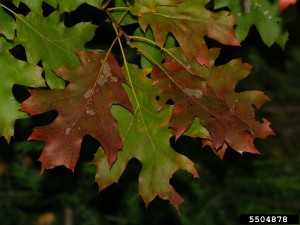
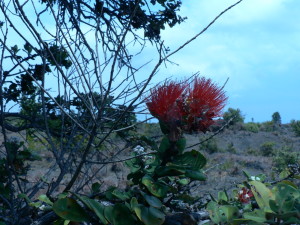
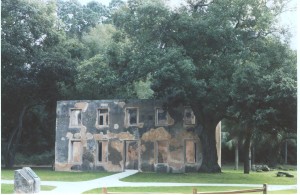
![CBP agriculture specialists in Laredo, Texas, examine a wooden pallet for signs of insect infestation. [Note presence of an apparent ISPM stamp on the side of the pallet] Photo by Rick Pauza](http://nivemnic.us/wp-content/uploads/2015/09/CPB-SWPM-inspection-300x200.jpg)
